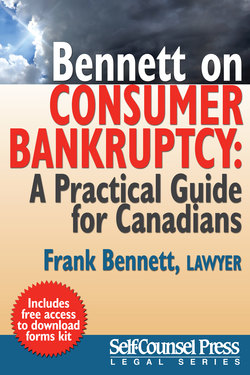Читать книгу Bennett on Consumer Bankruptcy - Frank Bennett - Страница 3
На сайте Литреса книга снята с продажи.
Preface
ОглавлениеI wrote a companion book for the small- and medium-sized business debtor called Bennett’s A–Z Guide to Bankruptcy: A Professional’s Handbook published by CCH Canadian Limited in Toronto. That book is similar to this one dealing with the same topics except from a business perspective. This book is devoted entirely to consumer and small-business debtors who want to take advantage of the favourable rules for consumers. It explains the bankruptcy process and alternatives available to the consumer debtor.
Canadian bankruptcy laws continue to change. For the first-time consumer debtor, bankruptcy is an easy solution to overwhelming debt problems. For individuals who wish to repeat bankruptcy proceedings, there are more restrictions, although not severe, when using the bankruptcy system.
According to the statistics kept by the Office of the Superintendent of Bankruptcy, in the year 2001, 92,836 Canadian consumers took bankruptcy protection. There were 79,453 consumer bankruptcies and 13,383 consumer proposals. Parliament has enacted laws which encourage consumers to make deals, or proposals as they are called, to the creditors rather than go fully bankrupt. With a declining economy, and with events following September 11, 2001, there were likely to be increases in consumer insolvencies. We live in an inflated economy, and at any given time, consumers cannot pay their credit card accounts and mortgage payments even with much lower interest rates. The recession of 2008 is continuing. In the year 2012, 118,398 consumers took bankruptcy protection. Of this number, 71,495 filed for bankruptcy and 46,903 filed consumer proposals.
People incur financial difficulties for many different reasons including marital strife or divorce, loss of job or plant closure, over-extension on credit cards, death of a key person in a business, and the bankruptcy of their businesses. Our bankruptcy laws are not onerous; in fact, they encourage individuals and companies to take protection from creditors who are pressing collection of their accounts. Being bankrupt does not have serious consequences for most individuals. Being bankrupt does not even mean that the debtor loses all his or her assets. In fact, with good legal advice, some assets can be protected against creditors. It’s important to see a lawyer first if you are considering filing for bankruptcy. Sometimes, certain assets can be protected; sometimes, the lawyer may advise you not to take protection.
Parliament changed the main bankruptcy laws somewhat in 1992, again in 1997, and then again in 2009 to encourage consumers and small-business debtors to make proposals to creditors rather than go bankrupt. The mechanical procedures for both proposals and bankruptcy were streamlined. Bankruptcy is no doubt the popular remedy. It is still very easy for a person to go bankrupt and it is still very easy for an individual to get discharged without too much difficulty or hardship. The system does not penalize the honest but unfortunate debtor, but it does free the debtor from most of his or her debts. However, there are few advantages for consumers to make proposals.
In this book, I give basic information to consumer and small- business debtors about the bankruptcy system. Lawyers, accountants, and financial planners and counsellors may find the book a good primer to Canada’s bankruptcy laws. In an office setting, I would take the individual consumer debtor through one or two interviews before recommending whether first, the client is a candidate for protection, and second, if so, how to go about it. I always ask the client for three pieces of paper: first, a list of assets; second, a list of debts or liabilities; and lastly, a list of questions. These lists focus the client on the problem at hand. With this information, I can give legal advice about the effects of bankruptcy on each of the assets and liabilities, as well as give answers to all the questions posed. Sometimes, the consumer debtor does not want to go into bankruptcy, and in these cases, some form of proposal or restructuring with the creditors may be possible.
It sounds easy. For most people, bankruptcy is a quick and easy solution to debt problems.
For the most part, individuals —
• want to know when they can get their credit cards back;
• want to know when it’s over; and
• do not care about the forms and formality, they just want to get credit again.
I hope that I take the mystique out the bankruptcy process and that more people will better understand how the system can work for them.
In preparation of this edition, I wish to thank Irving Burton, Jordan Rumanek, and Karen Adler, experienced trustees in bankruptcy in Toronto for their thoughtful comments and suggestions. I also wish to thank Eileen Velthuis, my critical editor who asked many skill-testing questions in her review of the book.
Frank Bennett, Toronto
